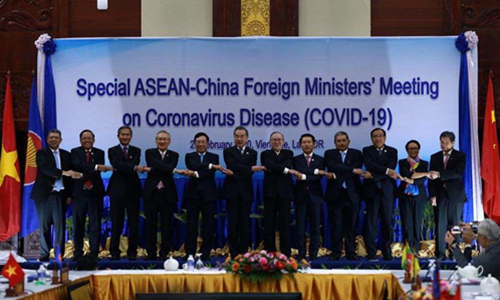Southeast Asia aware of China’s win-win approach and US strategic goals
By Li Kaisheng Source:Global Times Published: 2020/6/18 15:23:42

Chinese State Councilor and Foreign Minister Wang Yi (left 6) and foreign ministers of ASEAN countries attend the Special ASEAN-China Foreign Ministers' Meeting on Coronavirus Disease in Vientiane, Laos on February 20. Photo: Xinhua
The Center for Strategic and International Studies, a US think tank, recently published a survey of strategic elites in Southeast Asia and the Pacific on their views over, "the future of the Indo-Pacific from a Southeast Asia perspective." One of its founding ideas is that, "China is seen as holding slightly more political power and influence than the US in Southeast Asia today and considerably more power relative to the US in 10 years."
This findings from the survey are not unexpected. It basically affirms Southeast Asian political elites' views over the influence of China and the US in the region. They seem to be clearly aware of China's rise and the US' decline.
Thailand and the Philippines are referred to as the "oldest Asian allies" of the US. Washington has maintained its influence in the region since the end of World War II. Against this backdrop, why is Beijing holding more political power and influence than Washington in Southeast Asia?
China in recent years has ramped up its diplomatic activities with neighboring countries, including putting forward several initiatives, such as the Belt and Road Initiative. Beijing spares no efforts to play a positive role on the international stage and pursue a win-win result in the region too. Many of China's neighboring countries, including Southeast Asian ones, have recognized China's endeavors in this regard.
Furthermore, the US' willingness to engage in affairs of Southeast Asia is waning, and President Donald Trump didn't attach much importance to the region. This is partly because the US is contracting its strategic power when its might is declining. The Trump administration's stance toward this region differs from former president Obama's administration. For example, Trump was absent from summits with the Association of Southeast Asian Nations (ASEAN) in both 2018 and 2019, while Obama attended almost all US-ASEAN summits during his tenure.
Despite being an outside power, the US has repeatedly meddled with Southeast Asian affairs, especially the South China Sea. Although Trump continues to interfere in the region, he is selective of countries he intervenes in.
Trump on Saturday said at the West Point that the US is not "the policeman of the world." Under "America First" policy, Trump's rhetoric can be interpreted as saying that the US will pay less attention to global or regional affairs. However, as long as US' interests are concerned, the US will be reluctant to reduce its interference.
In spite of less interest in Southeast Asian affairs, the US realizes the South China Sea affairs can be used to contain China. As a result, instead of easing its meddling, the US actually seems to be investing more to interfere in the waters of the region. Washington on June 11 mobilized three aircraft carriers and their strike groups to patrol the Indo-Pacific waters.
There are certain disputes between China and its neighboring countries over territory. But these matters are supposed to be tackled by negotiations between them only. Yet Washington is reluctant to see the disputes addressed in peaceful ways without its involvement. The US has tried to use these rifts to deteriorate China's ties with its neighboring countries in a bid to contain China.
Southeast Asian countries have a clear sense of the US' strategic intention in the region. Most of them understand that US' involvement in the region is limited and once they really have conflicts with China, assistance offered by the US will be far from sufficient.
One article from Foreign Affairs, "The Endangered Asian Century: America, China, and the Perils of Confrontation," written by Singaporean Prime Minister Lee Hsien Loong, published on June 4, has captured global attention. It analyzes the challenge raised by escalating China-US tensions to Southeast Asian countries. For those countries, standing with one side only is a very difficult choice.
On one hand, Washington hopes they will take sides in an attempt to contain Beijing. On the other hand, Southeast Asian countries are part of China's neighborhood, thus their development is closely related to the world's second-largest economy. Aside from considerations of geopolitics, in order to pursue regional security and stability, for regional countries a relatively neutral position between the two giants is a rational choice.
The author is deputy director at the Institute of International Relations, the Shanghai Academy of Social Sciences. opinion@globaltimes.com.cn
Posted in: VIEWPOINT,CHINA-US